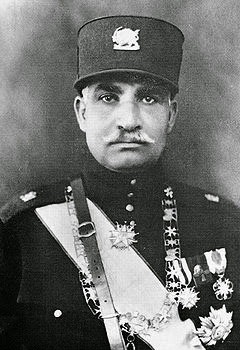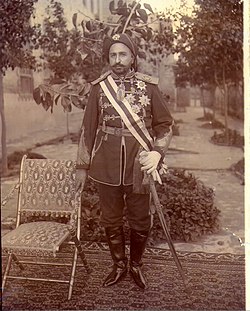Sheikh Khazal rebellion
| Sheikh Khazal rebellion | |||||||
|---|---|---|---|---|---|---|---|
| Part of Arab separatism in Khuzestan | |||||||
 The palace of Shaikh Khaz'al in Mohammerah at the bank of Shatt al-Arab In early 20th century | |||||||
| |||||||
| Belligerents | |||||||
| Supported by: | Emirate of Muhammara Bakhtiari Tribesmen | ||||||
| Commanders and leaders | |||||||
| | Khaz'al al-Ka'bi | ||||||
| Strength | |||||||
| 274 soldiers (1922)[3] 3,000 (1924) | More than 1,000 Arab militiamen[4] Several hundred Bakhtiari militiamen[citation needed] | ||||||
| Casualties and losses | |||||||
| 115 killed (1922)[3] | |||||||
The Sheikh Khazal rebellion[5] refers to the 1924 Arab separatist[citation needed] uprising by Khazal al-Kabi, the Sheikh of Muhammara, in Iranian Khuzestan. The rebellion was quickly and efficiently suppressed by Reza Shah with minimal casualties, subduing the Bakhtiari tribes allied with Sheikh Khazal and resulting in his surrender and the end of Arab autonomy in Khuzestan[citation needed]
Background
[edit]Khuzestan (also known as Arabistan) had become an autonomous functioning region[6] and remained much out of the reach of the central government by 1923. Prior to the rise of Reza Khan, foreign influence had significantly undermined Iran's independence and stability. During the Constitutional Revolution, Iranians attempted to eliminate Anglo-Russian dominance in their government but were unsuccessful. Following this period, Iran became a battleground during World War I, leading to British forces occupying much of the country and exerting control over the government in Tehran. As a result, cities such as Tabriz, Rasht, and Mashhad defied orders from Tehran, and many tribal populations, comprising about one-quarter of the populace, disregarded central authority.
In response to this situation, various Iranian leaders adopted four distinct policies: alignment with Britain, alignment with Russia, seeking support from a third power, and pursuing isolationism.[7][8] Sheikh Khazal, a prominent figure in Khuzestan, received British support, including approximately 3,000 arms and additional ammunition by 1919.[8] Although he collected taxes in the region, he remitted only a small fraction to the central government.[8]

In 1921, recognizing the threat posed by Reza Khan, who had recently staged a coup d'état with Seyyed Zia'eddin Tabatabaee, Sheikh Khazal took measures to protect himself. In February 1922, the Iranian government revisited the issue of taxation from the tribal areas of Mohammerah.[3]

From April 29 to May 2, 1922, Sheikh Khazal and Bakhtiari Khans convened in Dar-e Khazinah to establish cooperation. Another meeting in Ahvaz produced a formal agreement that Khazal and the Bakhtiaris would collaborate in all respects, while both pledged to "continue to serve the Iranian government faithfully and loyally."[3] This agreement was a significant step toward the formation of the Southern League.[3] The nucleus of the alliance, based on Sheikh Khazal and the Bakhtiaris, sought to attract additional members, including the Vali of Posht-e Kuh, Qavam ol-Molk of Khamsah, and possibly Sawlat ol-Dowlat.[3] However, the League lacked formal structure and was largely a temporary tribal confederation with shared interests.
Conflict
[edit]1922 events
[edit]In July 1922, a column of 274 Iranian soldiers, including 12 officers under command of Colonel Hasan Agha, were sent by Reza Khan to Khuzestan through the Bakhriari mountains to put pressure on Sheikh Khazal.[3] The Bakhtiaris, unaware that the column's destination was Khuzestan, and thinking their aim was to occupy their land, ambushed them and destroyed the force.[2] Only a handful of Iranian soldiers escaped the massacre.[2] Enraged, Reza Khan swore to take revenge on the ambush; the Bakhtiaris, however, requested to be informed of such military operations in the future, in order to avoid another clash. Reza Shah was however preoccupied with other troubles in the Iranian frontier, most notably the Kurdish rebellion of Simko Shikak, preventing him from immediately retaliating against the Bakhtiaris.[3] The troubles with the Bakhtiaris continued in mid-September, when two minor sheikhs of the Bakhtiaris destroyed the village of Chughurt.[3]
Negotiations
[edit]On 23 October 1923, Sheikh Khazal was ordered to relinquish much of his possessions to the central government, a demand he refused.[8] In response, Khazal attempted to form an alliance with the Bakhtiari, Lur, and Khamseh tribes to counteract Reza Shah's increasing power. His objective was to utilize this tribal alliance to make the Zagros Mountains a formidable barrier against the central government's forces. However, the various tribal groups frequently clashed with one another and were unable to reach agreements, leaving Khazal's proposal largely unanswered.
Sheikh Khazal then turned to Ahmad Shah Qajar and the Imperial Court of Tehran, presenting himself as a fiercely loyal defender and advocate of the Qajar dynasty, and urging the Court to take action against the ambitions of Reza Shah.[citation needed] This effort also proved unsuccessful. Khazal then sought to ally himself with the Majles (Iranian Parliament) opposition to Reza Shah, writing several letters to the opposition leader, Ayatollah Seyyed Hassan Modarres. In these letters, Khazal portrayed himself as a staunch constitutionalist from the inception of the movement, emphasizing his identity as an Iranian nationalist and a liberal democrat who found Reza Shah's authoritarianism personally offensive. The opposition cautiously accepted Khazal's proposal, albeit with considerable deliberation due to their distrust of him. However, the parliamentary opposition to Reza Shah ultimately failed.
Indifference from the Qajar court and the refusal of the British to support him ultimately led Sheikh Khazal to appeal to the League of Nations in 1924. He sought international recognition of his sheikhdom and support for the separation of his territory from Iran. This effort, however, ended in failure. Before the rise of Reza Shah, Khazal had never attempted to separate his sheikhdom from Qajar Persia, to which he had remained staunchly loyal.[citation needed]
November 1924
[edit]In November 1924, Reza Pahlavi dispatched 3,000 soldiers to subdue the rebellious Sheikh Khazal.[9] Two task forces were organized: one for Dezful, headed by Major-General Ayrom, and another, under General Zahedi and Colonel Ali Akbar Javaheri-Farsi, which advanced from Isfahan and Shiraz through the Zagros Mountains into the Khuzestan Plain. The force under General Zahedi and Colonel Javaheri-Farsi defeated the Bakhtiari tribe, who were Khazal's allies, and brought other Bakhtiari groups into submission. Reza's arrival in Bushehr and the concentration of Iranian soldiers around Ahwaz persuaded Sheikh Khazal to seek a negotiated settlement.[10] During the rebellion of Arabs in Mohammerah, on July 24, 1925 British forces provided logistical and naval support to the Persian government. A report from the British Vice-Consul in Muhammara stated that, following the Arabs capture of Mohammerah, British officials requested reinforcements from Basra. In response, the Royal Navy deployed H.M.S. Triad along with armored vehicles and additional troops, aiding the Persian reoccupation of Muhammerah on July 25, 1925 in which 130 Arabs were killed.[11]
Khazal sought London protection, but the British deemed his position untenable and instead backed Reza Pahlavi as a bulwark against Soviet influence. Realizing he had lost British support, Khazal disbanded his Arab forces and retired to Muhammara. In return for his submission, Reza Pahlavi granted him a pardon, and Iranian troops occupied Ahwaz while military governors were installed in the region. However, this arrangement did not last long, and in April 1925, Reza ordered General Zahedi to capture Khazal.[10]
Aftermath
[edit]1925 conclusion
[edit]In January 1925, Reza Shah dispatched military commanders to Khuzestan to assert the authority of the provisional government in Tehran. An Imperial farman (executive order) was issued, restoring the province's old name, Khuzestan, instead of Arabistan, and Sheikh Khazal lost his authority over the various tribes under his command.
Later that spring, Reza Shah made two attempts to convince Khazal to meet him in Tehran to discuss his position in the new government. However, Khazal was suspicious of Reza Shah's motives and refused to go, stating that he would send an emissary instead. In April 1925, Reza Shah ordered one of his commanders, General Fazlollah Zahedi, who had a friendly relationship with Khazal, to meet with him and ostensibly convince him to travel to Tehran. General Zahedi, accompanied by several government officials, met with Khazal and spent an evening on his yacht, anchored in the Shatt al-Arab river.
Later that evening, a gunboat led by Meguertitch Khan Davidkhanian, sent by Reza Shah, stealthily approached the yacht, which was then boarded by fifty Persian marines. The soldiers arrested Khazal and transported him by motorboat to Mohammerah, where a car awaited to take him to a military base in Ahvaz. From there, he was taken to Dezful, accompanied by his son, then to the city of Khorramabad in Lorestan, and eventually to Tehran. Upon his arrival, Khazal was warmly greeted and well received by Reza Shah, who assured him that his problems would be quickly settled and that he would be treated well in the meantime. However, many of Khazal's personal assets in Iran were swiftly liquidated, and his properties eventually came under the domain of the Imperial government after Reza Shah was crowned the new Shah. The sheikhdom was abolished, and the provincial authority took full control of regional affairs, eliminating any form of local Arab autonomy.
House arrest and death
[edit]Sheikh Khazal spent the rest of his life under virtual house arrest, restricted from traveling beyond Tehran's city limits. Despite this, he retained ownership of his properties in Kuwait and Iraq, where he was exempt from taxation. He died in May 1936 while alone in his house, as his servants had been taken to court by the police earlier that day. It is claimed that he did not die of natural causes but was murdered by one of the guards stationed outside his house, allegedly under direct orders from Reza Shah.
See also
[edit]Further reading
[edit]- Shahnavaz, Shahbaz (2013). "Ḵazʿal Khan". Encyclopædia Iranica. Vol. XVI, Fasc. 2. pp. 188–197.
References
[edit]- ^ Qatar Digital Library, British Report on the Arab Rising in Muhammara, 1924
- ^ a b c Bakhtiary, A. M. The Last of the Khans: The Life of Morteza Quli Khan Samsam Bakhtiari. p155. [1]
- ^ a b c d e f g h i Cronin, S. Tribal Politics in Iran: Rural Conflict and the New State, 1921–1941. pp52-5. [2]
- ^ Bāstānī Pārīzī, Muḥammad Ibrāhīm. Talāsh-i āzādī: muḥīṭ-i siyāsī va-zindagāni-yi Mushīr al-Dawlah Pīrniyā. Bā tajdīd-i naẓar-i kāmil. Iran: Mohmaad Ali 'Elmil, 1968. p.420
- ^ Price, M. Iran`s diverse peoples: a reference sourcebook. p.159. "... and finally supporting a rebellion by Shaykh Khazal." [3]
- ^ Yazdi, Leila Papoli (March 2013). "What He Thought...What He Did: An Archaeological Study of the Persian Gulf Coasts Colonial Sites of Sheikh Khazal Khan in the Early Twentieth Century". International Journal of Historical Archaeology. 17 (1): 1–17. doi:10.1007/s10761-013-0216-3. JSTOR 23352199. Retrieved 10 September 2023.
- ^ Zirinsky, Michael P. (Nov 1992). "Imperial Power and Dictatorship: Britain and the Rise of Reza Shah, 1921-1926". International Journal of Middle East Studies. 24 (4): 639–663. doi:10.1017/S0020743800022388. JSTOR 164440. Retrieved 10 September 2023.
- ^ a b c d Farrokh, K. (2011). Iran at War: 1500-1988. Osprey Publishing Limited. ISBN 9781780962214. Retrieved 2015-02-11.
- ^ Ward Steven R. Immortal: A military history of Iran and its armed forces. p.138. [4]
- ^ a b Ward Steven R. Immortal: A military history of Iran and its armed forces. p.139. [5]
- ^ Qatar Digital Library, British Report on the Arab Rising in Muhammara, 1924


 French
French Deutsch
Deutsch